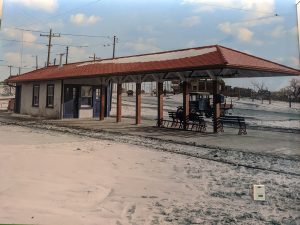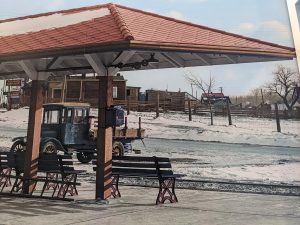Robert Lansdale has shared a 1929 photo from Long Branch, Ontario
Robert Lansdale has shared a captivating historical photo from a mural at a TD Bank at the East Mall in Etobicoke.
It may be the case (and I could be wrong) that the background of the 1929 photo may be equivalent to the eastern triangle corner of the Dominion parking lot which is depicted at a subsequent post.

The image source, as I understand, is the Toronto Archives, Fond 16, Series 71, Item 6588. Two sources I have been in touch with have suggested this may be a colourized version of the archival photo.
I prefer to proceed with care, before I say anything about any matter.
As is noted, by way of example, at the same subsequent post, the misinformation that the Colonel Smith log cabin was bulldozed in 1952 stands in strong contrast to the evidence – from solid, verifiable sources – that it was demolished in 1955.

The image source, as I understand, is the Toronto Archives, Fond 16, Series 71, Item 6588. Two sources I have been in touch with have suggested this may be a colourized version of the archival photo.
I mention this because, of all of the things I’ve learned about writing over the past half-century and more, the first thing that comes to mind, whenever I seek to say anything about anything, is: “What is the evidence, on which I base this statement?”
If a person says the Smith cabin was demolished in 1952, I would want to know: “What is the evidence?”
If the answer is: “Well, I read it on the internet,” or, “I read it in a book in the library,” then what the person is saying is that they accept much of whatever they are told, without reflection and without further thought, regarding topics such as local history. [1]


Note 1
If I remember correctly, a photo or photos, donated by a local historian to the Montgomery’s Inn archives in Etobicoke, of the Colonel Smith house, has a caption that says the house was torn down in 1952.
Somebody might say, “It says in the archives that it was torn down in 1952.”
To which I would say, “Even if it says this, or says that in some archival resource, you still have to take care; you still need to verify, to corroborate; you can’t just accept that something that turns up in some archive is the final word on anything.”
The broader topic relates to evidence and evidence-based practice.
As well, when we deal with evidence, we deal with the philosophy and history of science.
In addition, when we deal with evidence, we deal with the role that framing plays in the acquisition, assessment, and evaluation of it.
On top of that, when we deal with evidence, we also deal with power relations. This is clear to us, in the COVID-19 era as in any other era, in the past or future, when we consider how evidence is used.
It’s a matter that is also clear to us when we consider how evidence is misused, as in the case, for example, where power, or the pursuit of it, gives rise to the phenomenon that qualifies as gaslighting.